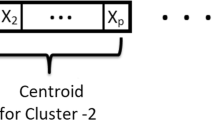Abstract
Clustering as a data exploration technique is very widely applied. It is based on clustering algorithms whose usefulness depends strictly on the form and style of the incoming data. The following article comparing operator in evolutionary algorithms used to clustering of symbolic data. Clustering methods is based on list of decision rules.
Access this chapter
Tax calculation will be finalised at checkout
Purchases are for personal use only
Preview
Unable to display preview. Download preview PDF.
Similar content being viewed by others
References
C. L. Blake and C. J. Merz. UCI repository of machine learning databases, 1998
P. Cichosz. Systemy uczace sie. WNT, Warszawa, 2000
P. Clark and T. Niblett. The CN2 induction algorithm. Machine Learning, 3:261–283, 1989
R. O. Duda and P. E. Hart. Pattern Classification and Scene Analysis. Wiley, New York, 1973
D. Fisher. Iterative optimization and simpliFIcation of hierarchical clusterings. Journal of Artificial Intelligence Research, 4:147–180, 1996
D. Mazur. Clustering algorithm based on a sequence of discriminant rules. In T. Burczyński, W. Cholewa, and W. Moczulski, editors, Methods of Artificial Intelligence, Gliwice, 2003. AI-METH Series.
D. Mazur. Clustering based on genetics algorithm. In T. Burczyński, W. Cholewa, and W. Moczulski, editors, Methods of Artificial Intelligence, Gliwice, 2004. AI-METH Series
R. T. Ng and J. Han. Effcient and effective clustering methods for spatial data mining. In J. Bocca, M. Jarke, and C. Zaniolo, editors, 20th International Conference on Very Large Data Bases, pages 144–155, Los Altos, USA, 1994. Morgan Kaufmann Publishers
M. Perkowitz and O. Etzioni. Towards adaptive Web sites: conceptual framework and case study. Computer Networks (Amsterdam, Netherlands: 1999), 31(11–16):1245–1258, 1999
Author information
Authors and Affiliations
Editor information
Editors and Affiliations
Rights and permissions
Copyright information
© 2005 Springer-Verlag Berlin Heidelberg
About this paper
Cite this paper
Mazur, D. (2005). Comparing Modifcation Operators Used in Clustering Algorithm Based on a Sequence of Discriminant Rules. In: Kurzyński, M., Puchała, E., Woźniak, M., żołnierek, A. (eds) Computer Recognition Systems. Advances in Soft Computing, vol 30. Springer, Berlin, Heidelberg. https://doi.org/10.1007/3-540-32390-2_29
Download citation
DOI: https://doi.org/10.1007/3-540-32390-2_29
Publisher Name: Springer, Berlin, Heidelberg
Print ISBN: 978-3-540-25054-8
Online ISBN: 978-3-540-32390-7
eBook Packages: EngineeringEngineering (R0)




